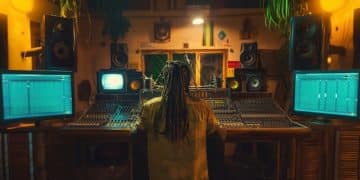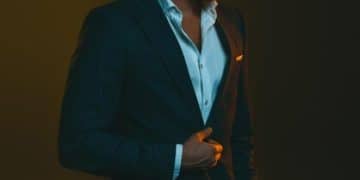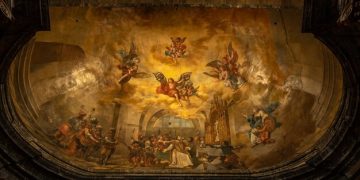Rediscovering Lost Art: Practical Effects Masterpieces Before CGI

Rediscovering the Lost Art of Practical Effects: How Forgotten Masterpieces Achieved Cinematic Magic Before CGI Domination delves into the ingenious pre-digital methods that shaped legendary films, showcasing the enduring power of tangible artistry in creating unforgettable cinematic experiences.
Before the ubiquitous reign of computer-generated imagery (CGI), filmmakers relied on a fascinating array of techniques to bring their wildest visions to life. It’s a journey into the heart of cinematic innovation, where skill, persistence, and creativity converged to forge timeless movie moments. This exploration into Rediscovering the Lost Art of Practical Effects: How Forgotten Masterpieces Achieved Cinematic Magic Before CGI Domination sheds light on an era when every monster, every explosion, and every fantastical landscape was meticulously crafted by hand, leaving an indelible mark on film history.
The golden age of tangible illusions: before the digital dawn
The history of cinema is deeply intertwined with the quest for breathtaking visual spectacle. For decades, long before pixels dominated the screen, special effects artists were the unsung heroes, magicians who painted with light, foam, and meticulously engineered machinery. Their workshops were crucibles of innovation, where imagination was translated into physical reality, piece by laborious piece. This era, often celebrated as the golden age of practical effects, defined cinematic magic for generations.
Filmmakers of this period understood that the tactile nature of practical effects resonated deeply with audiences. There was an undeniable weight, a physical presence to these illusions that CGI, despite its limitless possibilities, sometimes struggles to replicate. The imperfections, the subtle textures, and the way light interacted with these physical constructs created a verisimilitude that was often breathtakingly convincing. This commitment to tangible artistry fostered a unique relationship between the film and its viewer, building trust in the on-screen reality.
Pioneers of the craft: pushing boundaries with ingenuity
The evolution of practical effects was driven by visionary artists constantly seeking new ways to defy audience expectations. From simple matte paintings to complex animatronics, each innovation built upon the last, collectively expanding the cinematic vocabulary. These pioneers didn’t just create effects; they created entire worlds, often with limited budgets and tight deadlines, relying on pure inventive spirit.
- Georges Méliès: The father of special effects, whose early 20th-century work laid the groundwork for visual trickery with in-camera edits and double exposures.
- Ray Harryhausen: A stop-motion animation maestro who brought mythical creatures to life with unparalleled artistry and emotional depth, inspiring countless filmmakers.
- Stan Winston: A legendary creature creator and make-up artist responsible for iconic characters, setting new standards for animatronics and prosthetic effects.
These artists, and many others, were not merely technicians; they were storytellers themselves, using their craft to enhance narrative and immerse viewers in incredible fictional realities. Their work underscored the principle that effects should serve the story, not overshadow it, a philosophy that remains relevant even today.
The ingenuity displayed during this period was remarkable. Artists often concocted bespoke solutions for unique cinematic challenges, transforming ordinary materials into extraordinary sights. This required not only immense technical skill but also a profound artistic sensibility, understanding how light, shadow, and perspective could trick the eye and suspend disbelief. The legacy of these master illusionists continues to influence contemporary filmmaking, even in an era dominated by digital tools.
Stop-motion wonders: bringing the impossible to life frame by frame
Among the pantheon of practical effects, stop-motion animation holds a special, almost revered place. It is a painstaking art form, requiring unimaginable patience and precision, where inanimate objects are moved incrementally, frame by frame, to create the illusion of independent motion. The result, when done masterfully, is a unique blend of dreamlike movement and tangible realism that can be profoundly captivating.
The magic of stop-motion lies in its ability to grant life to the fantastical. Creatures that could never exist in the real world, from towering dinosaurs to mythical beasts, suddenly stride, fly, and battle with convincing, often unnerving, grace. This technique allowed filmmakers to bypass the limitations of live-action cinematography and transport audiences into realms where imagination reigned supreme, long before digital models made such feats commonplace.
Ray Harryhausen: a titan of stop-motion animation
No discussion of stop-motion is complete without acknowledging the monumental contributions of Ray Harryhausen. His name is synonymous with the art form, having almost single-handedly defined creature animation for decades. Harryhausen’s creations were not just monsters; they possessed personality, weight, and a peculiar charm that endeared them to audiences, even as they inspired terror.
- “Jason and the Argonauts” (1963): The skeleton army sequence remains a legendary achievement, a masterclass in choreographed, multi-character stop-motion.
- “Clash of the Titans” (1981): Featuring iconic creatures like Medusa and the Kraken, it was a swan song for traditional stop-motion in big-budget fantasy films.
- “The 7th Voyage of Sinbad” (1958): Introduced audiences to a cyclops and a dragon, showcasing Harryhausen’s ability to imbue models with emotive qualities.
Harryhausen’s technique, often involving rear projection to seamlessly integrate his animated figures with live-action footage, was revolutionary. He understood perspective and movement in a way few others did, making his creatures feel like genuine inhabitants of the cinematic world. His process was slow, meticulous, and incredibly demanding, but the results were unparalleled, securing his legacy as one of cinema’s most influential special effects artists.
The beauty of Harryhausen’s work, and stop-motion in general, extends beyond technical achievement. It’s the palpable sense of human artistry behind every movement, every flickering frame. Audiences subconsciously connect with this handcrafted quality, providing an authentic texture that digital effects often struggle to replicate. This tangible connection is a significant part of the enduring allure of “lost masterpieces” created through stop-motion.
Miniature marvels and forced perspective: building worlds on a small scale
Creating vast, impossible worlds on a limited budget was a consistent challenge for early filmmakers. The ingenious solution often lay in miniatures and forced perspective, techniques that allowed colossal structures, sprawling cities, or alien landscapes to be conjured into existence using tiny models and clever camera angles. These methods were essential in crafting the spectacle of films that predated sophisticated digital environments.
Miniature work involved constructing small-scale replicas of objects or settings, which were then filmed to appear full-sized. When combined with forced perspective—a technique that manipulates human visual perception through the use of optical illusions to make objects appear farther away, closer, larger or smaller than they actually are—filmmakers could create astonishing depth and scale. This required not only skilled model-making but also a deep understanding of optics and photographic principles.
The grandeur of tiny sets: illusion on a grand scale
Many classic films could not have achieved their epic scope without the use of miniatures. From the destruction of cities to the creation of futuristic metropolises, models provided a cost-effective and visually convincing way to depict environments that were otherwise impossible to build at full scale. The level of detail achieved by these model makers was often extraordinary, rendering them indistinguishable from their real-world counterparts on screen.
- “Metropolis” (1927): Fritz Lang’s masterpiece utilized stunning miniature cityscapes to depict a dystopian urban future, creating an enduring visual iconography.
- “Blade Runner” (1982): The intricate, rain-soaked future Los Angeles was largely realized through elaborate miniature models, giving the film its distinctive neo-noir aesthetic.
- “2001: A Space Odyssey” (1968): Stanley Kubrick’s vision of space travel and alien encounters relied heavily on exquisitely detailed spaceship miniatures and celestial backdrops.
The art of forced perspective, meanwhile, became a staple for creating illusions of scale, particularly when pairing actors with miniature elements. By carefully aligning objects at different distances from the camera, filmmakers could make characters appear to interact with massive monsters or stand beside towering landmarks. This required precise camera control and actor positioning, turning every shot into a carefully orchestrated optical trick.
The beauty of miniature marvels and forced perspective lies in their tangible nature. Unlike digital creations, these models exist physically, capable of interacting with real light, water, and atmospheric effects in a way that often feels more grounded. This inherent realism, born from physical construction, profoundly contributed to the “cinematic magic” that audiences experienced, proving that sometimes, bigger is indeed better, even when starting small.
Prosthetics and animatronics: embodying creatures with practical artistry
When the cinematic narrative called for non-human characters, be they terrifying monsters, grotesque aliens, or lovable companions, practical effects artists turned to prosthetics and animatronics. These techniques allowed for the creation of characters with unparalleled physical presence, tactile reality, and often, emotional depth that resonates powerfully with audiences. Unlike purely visual effects, prosthetics and animatronics bring characters into the physical space of the film, interacting directly with actors and sets.
Prosthetic makeup involved applying specially designed materials to an actor’s face or body to alter their appearance, morphing them into something entirely new. Animatronics, on the other hand, brought life to entirely fabricated creatures, using robotics, hydraulics, and cable controls to articulate movements, expressions, and even vocalizations. Together, these methods formed the backbone of creature design in cinema for decades, producing some of the most iconic characters in film history.
Stan Winston and the legacy of creature creation
Stan Winston is arguably the most celebrated name in the field of prosthetic makeup and animatronics. His studio produced a string of groundbreaking works that redefined what was possible for on-screen creatures. Winston’s philosophy centered on the idea that the creature should feel real, present in the environment, and capable of conveying complex emotions. His meticulous attention to detail and innovative engineering transformed latex, foam, and wiring into living, breathing cinematic beings.
- “Aliens” (1986): Winston’s Queen Alien animatronic was a monumental achievement, a terrifying and majestic creature that moved with incredible fluidity and menace.
- “Jurassic Park” (1993): The film blended groundbreaking CGI with full-scale animatronic dinosaurs, proving the undeniable impact of physical creatures. The T-Rex and Velociraptors felt undeniably real and menacing.
- “Terminator 2: Judgment Day” (1991): While also using CGI, the film featured extensive practical effects for the T-800’s damaged states and the T-1000’s physical manifestations, demonstrating the power of hybrid approaches.
The artistry in these effects goes beyond mere replication; it’s about embodiment. Actors reacting to a physical animatronic or a prosthetically enhanced co-star often deliver more authentic performances. The weight, the texture, and the sheer physical presence of these creations immerse both the actors and the audience more deeply into the narrative. This collaborative dance between practical designers, directors, and performers elevated the art of monster-making to new heights.
Moreover, the inherent limitations of animatronics often spurred creativity. Artists had to find clever ways to suggest movement or emotion within mechanical constraints, leading to iconic character designs and memorable on-screen moments. The legacy of these practical creatures endures, frequently proving that sometimes, seeing is believing, especially when what you’re seeing is physically there.
Matte paintings and glass shots: conjuring distant worlds on a canvas
Before green screens and digital set extensions became standard, filmmakers frequently turned to matte paintings and glass shots to transport audiences to exotic locales, futuristic cities, or fantastical realms that existed only in their imaginations. These techniques, often executed with breathtaking skill, allowed for the seamless integration of painted backdrops with live-action footage, creating an illusion of grandeur and scale on a relatively modest budget.
A matte painting involves a painted artwork, typically on a large sheet of glass or board, depicting a background or set extension. This painting is then photographed and combined with separate footage of the live-action elements. Glass shots were a variation where parts of the scene were painted directly onto a sheet of glass positioned between the camera and the live set, allowing for in-camera composition of real and painted elements.
The invisible art: creating cinematic scale with paint and glass
The art of matte painting was often referred to as “the invisible art” because its greatest success lay in its seamlessness—audiences were meant to believe they were seeing a vast, real environment. The artists meticulously matched perspective, lighting, and texture to blend their painted creations with the live-action footage, creating an immersive cinematic experience.
- “Citizen Kane” (1941): Used matte paintings extensively to create the towering Xanadu mansion and its vast grounds, adding to the film’s opulent yet desolate atmosphere.
- “The Wizard of Oz” (1939): The Emerald City and other fantastical landscapes were brought to life through vibrant matte paintings, contributing to the film’s iconic visual style.
- “Star Wars: Episode V – The Empire Strikes Back” (1980): The majestic cloud city of Bespin and the arctic landscapes of Hoth were significantly enhanced by masterful matte paintings.
Glass shots provided an even more organic way to combine painted elements with live-action. By carefully aligning the painted glass with the real set, filmmakers could add architectural details, distant mountains, or cosmic vistas directly into the shot, all captured in a single exposure. This technique demanded immense precision from both the painter and the cinematographer, ensuring that light and focus were perfectly matched across both real and painted sections.
The appeal of these techniques lies in their inherent artistic quality. Each matte painting was a unique work of art, infused with the painter’s vision and skill. The subtle brushstrokes, the deliberate choice of colors, and the masterful use of atmospheric perspective contributed a rich, handcrafted texture to the film’s visual fabric. This traditional approach to visual effects often resulted in images that possessed a timeless beauty, proving the enduring power of classic artistry in cinema.
The enduring legacy: why practical effects still matter
In an age where nearly anything can be generated digitally, one might wonder if the art of practical effects has become obsolete. However, a growing number of filmmakers and enthusiasts argue for the continued relevance, and indeed, resurgence, of these tangible techniques. The shift towards CGI, while offering boundless possibilities, has sometimes come at the cost of a certain authenticity, a physical weight that practical effects inherently possess.
Practical effects create a tangible connection with the audience. When a monster is a physical puppet or an explosion is a controlled pyrotechnic event, there’s an undeniable realism that grounds the viewer in the film’s world. The way real light interacts with a physical object, the subtle imperfections, and the direct interaction with actors on set often lead to more believable and impactful moments.
The case for tangible artistry in modern cinema
Many contemporary productions are rediscovering the value of practical effects, often integrating them with CGI in a hybrid approach. This blended methodology leverages the strengths of both worlds: the limitless possibilities of digital effects for massive scale and complex transformations, combined with the tactile reality and immediacy of practical elements for close-ups and key interactive moments. The result is often a more convincing and immersive visual experience for the audience.
- Increased Realism: Physical models, puppets, and sets react to light, gravity, and environmental factors in a way that CGI often struggles to perfectly replicate spontaneously.
- Actor Performance: Actors often deliver more authentic reactions when interacting with a physical presence rather than a tennis ball on a stick representing a digital character.
- Tactile Experience: There’s a certain charm and weight to practical effects that reminds the audience of the craft involved, fostering a deeper appreciation for the filmmaking process.
The resurgence isn’t just about nostalgia; it’s about effectiveness. Directors are increasingly aware that an over-reliance on CGI can, paradoxically, make certain scenes feel less real, less impactful. A well-executed practical effect can deliver a punch that even the most sophisticated digital rendering might miss, precisely because of its physical presence in the shot.
Movies like “Dune” (2021) and “Mad Max: Fury Road” (2015) stand as testaments to the power of integrating practical effects with digital enhancements. These films demonstrate that an intelligent combination of both approaches can yield visually stunning and incredibly immersive cinematic worlds. Rediscovering and championing practical effects isn’t about rejecting progress; it’s about embracing a richer, more diverse toolkit for cinematic storytelling, ensuring that the magic of tangible illusions continues to enchant audiences for generations to come.
Beyond the screen: the cultural impact of practical effects
The influence of practical effects extends far beyond the confines of the silver screen, deeply embedding itself in popular culture and inspiring countless artists, filmmakers, and enthusiasts. The iconic creatures, fantastical landscapes, and memorable moments created through these ingenious techniques have become touchstones of cinematic history, shaping our collective imagination and the very language of visual storytelling.
Many characters brought to life through practical effects—from King Kong to the xenomorph—are instantly recognizable, cultural icons that transcend the films they originated from. These creations, born from the hands of skilled artists, possess a unique charm and lasting presence that often imprints itself more vividly on the audience’s mind than their digital counterparts. This is perhaps due to the unique blend of artistry and tangible reality inherent in their creation.
Inspiring generations and preserving cinematic heritage
The dedication and inventiveness of practical effects artists have inspired generations to pursue careers in filmmaking, art, and engineering. The detailed work of a stop-motion animator, the intricate mechanics of an animatronic puppet, or the painterly beauty of a matte painting are not just technical achievements but works of art that ignite passion and creativity. Their impact can be seen in various forms across different media platforms.
- Film Education: Practical effects techniques are taught in film schools worldwide, emphasizing foundational principles of visual storytelling and physical production.
- Collector’s Market: Original props, models, and sketches from practical effects-heavy films are highly sought after by collectors, testifying to their artistic and historical value.
- Fan Art and Cosplay: The tangible nature of practical designs makes them highly adaptable for fan interpretations, from intricate cosplay costumes to detailed fan art.
Moreover, the preservation of practical effects models, puppets, and behind-the-scenes documentation actively contributes to cinematic heritage. These artifacts are housed in museums and archives, serving as valuable educational tools and enduring tributes to the artists who crafted them. They offer a tangible link to a pivotal era of filmmaking, allowing new audiences to appreciate the meticulous artistry involved in pre-CGI productions.
The cultural conversation around practical effects often highlights the “how” behind the magic, demystifying the process while simultaneously deepening appreciation for the craft. Documentaries, special features, and retrospectives celebrating these techniques continue to captivate audiences, proving that the fascination with physical illusion is as strong as ever. This ongoing dialogue ensures that the techniques of practical effects remain a vibrant and respected part of cinematic lore, influencing future generations of storytellers and special effects practitioners.
| Key Aspect | Brief Description |
|---|---|
| 🎞️ Stop-Motion | Frame-by-frame animation giving life to models, pioneered by artists like Ray Harryhausen. |
| 📏 Miniatures & Forced Perspective | Building worlds on a small scale to create grand illusions of size and distance. |
| 🎭 Prosthetics & Animatronics | Physical makeup and robotic creatures providing tangible presence and interaction. |
| 🎨 Matte Paintings | Hand-painted backdrops seamlessly blended with live-action for expansive set extensions. |
Frequently Asked Questions About Practical Effects
Practical effects refer to physical effects produced directly on set during filming, without the use of computer-generated imagery. These include pyrotechnics, animatronics, prosthetics, miniatures, stop-motion animation, and forced perspective. They aim to create visual spectacles that interact tangibly with the real environment and actors, providing a sense of physical weight and realism often sought after by filmmakers seeking authentic on-screen presence.
With the rise of CGI in the late 20th and early 21st centuries, many traditional practical effects techniques saw a significant decline in usage. CGI offered unprecedented flexibility, speed, and reduced physical risk, leading many productions to favor digital solutions. This shift resulted in a generation of filmmakers and audiences less familiar with the intricate craftsmanship and ingenuity required for physical effects, making them seem like a “lost art” compared to the prevalent digital workflow.
“Star Wars” extensively used a variety of practical effects to create its iconic universe. Miniatures were crucial for spaceships and epic battles, while matte paintings built futuristic cityscapes and alien environments. Creative costumes and creature suits brought alien species to life, and pyrotechnics created explosions. These tangible elements contributed immensely to the films’ groundbreaking realism and immersion, helping to create a believable galaxy far, far away that captivated audiences.
Yes, practical effects are still very much in use today, often in conjunction with CGI in a hybrid approach. Filmmakers value practical effects for the genuine physical presence they provide, allowing actors to interact with real objects and creatures, which often enhances performance. They also offer a unique tactile realism and a sense of weight that can be difficult for CGI alone to replicate, contributing to more grounded and impactful cinematic moments.
Several pioneers shaped the world of practical effects. Georges Méliès laid early foundations with in-camera tricks. Ray Harryhausen revolutionized stop-motion animation, creating countless mythical creatures. Stan Winston became a legend for his animatronics and prosthetic makeup, crafting iconic characters like the Alien Queen and the T-Rex. These individuals, among others, pushed boundaries and defined cinematic magic long before the digital age, leaving an enduring legacy on filmmaking.
Conclusion: The Undying Allure of Tangible Magic
The journey through the forgotten masterpieces of practical effects reveals not just a history of ingenious cinematic artistry, but a profound testament to human creativity and skill. From the painstaking frame-by-frame animation of stop-motion to the meticulous construction of miniatures and the intricate puppetry of animatronics, these techniques built worlds and characters that deeply resonated with audiences, defining generations of cinematic spectacle. While CGI now offers almost limitless possibilities, the enduring power of practical effects lies in its tangible reality, its ability to ground the fantastical in something physically present and undeniably real. It’s a magic born of hands-on craftsmanship, a testament to the fact that sometimes, the most astonishing illusions are those we can almost reach out and touch. The rediscovery of this lost art reminds us that imagination, paired with dedication, can create cinematic moments that are truly timeless, ensuring that the legacy of tangible magic continues to inspire and entertain for years to come.
